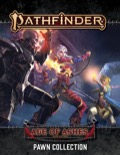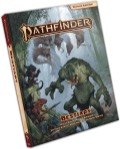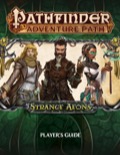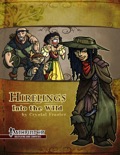Sign in to create or edit a product review. 
Pathfinder Bestiary 2 Pawn CollectionPaizo Inc.Add Print Edition $39.99 Add PDF $9.99 Non-Mint Unavailable Good but with the same issue as Heroes & VillainsI found the collection to be as good as the previous one. Paying ~10$ less for no box and no bases is a good deal IMO, but it should have been communicated better, maybe right on the cover. There might be some marketing rule about not placing negatives at the most visible places, but customer agency is more important in my book. I bought the package as a pawn collector, so I won't comment on the completeness issue (see demlin's review for that). Quality is high, as usual for Pathfinder Pawns. The composition is typical for an AP, with a lot of (quasi-) humanoid NPCs and many (often Medium sized) monsters. A few NPCs suffer from oversized heads IMO - it's mainly the "bloody blade mercenary" and "scarlet triad agent / boss" pieces, but there are also a few borderline cases, like Akosa. Otherwise I found the artwork okay to good, with no piece being exceptionally impressive. Technical note: If you want more reviews, getting rid of the "You backtracked too far" issue (looks like a timeout) would absolutely help... This package has actually close to 500 pawns, so the individual piece is still really cheap. As a collector, I see new artwork pretty much everywhere. In average I find it a bit better than the artwork of the PF1 Bestiary 1. There are several outstanding pieces (such as excellent and diverse elementals for all sizes), but also a few offenders (don't get me started on the comical looking balor). Very few pieces have an unfortunate scaling, for example the lemure appears really massive, while the quasit is hard to see (yes, the creature is tiny sized, but still...). If you want to add the pawns to a PF1 collection, the only issue might be the renaming of a few creature types. Most of it is straight-forward ("derro" to "dero"), darkfolk now being called caligni is among the biggest changes. The new artwork means you can easily treat the newcomers as special versions. Given there are actually not that many new monsters, most pawns work for PF1 campaigns, even without porting the new monsters back. Two of the sheets had very minor material damage, but nothing that would impact the fun. I'd give 4.5 stars if I could - given Paizo's friendly pricing here, I don't mind rounding up to 5 stars. Looking forward to the Bestiary 2 box and all the other upcoming pawns! Ok, this book is not just a rework of PF1's Bestiary, the changes are numerous: Artwork
Artwork (continued)
Monster grouping
Naming policy
New and old monsters
Shorter statblocks
Playable races
More monsters
Finally, I am not so happy to see all these good outsiders among the first pages. Yes, they all start with "A" and have their fans. But at least for me, a Bestiary's primary purpose is to pull enemies out of it. And few groups will end up fighting angels, archons or azatas on a regular basis. So overall, it's a solid book - it looks like it gets its job done, but doesn't have "awesome" written all over it. Newcomers might be happier with it than PF1 veterans. 
Pathfinder Pawns: Enemy Encounters Pawn CollectionPaizo Inc.Print Edition Unavailable Add PDF $9.99 Convincing final non-AP pawn setNo review yet? Alright. This set covers 8 different groups of monsters and adds a page of dungeon decor on top of it. It can be seen as Paizo's offer for people who missed the (awesome) Monster Codex Pawn Box, and it does pretty well as a replacement. From my gut feeling half of the art is actually new for pawns. Several pieces seem to be exclusive for this set, actually. Multiple new duergar pawns are quite impressive, I am also a fan of of some skeletons (for example the dual-wiedling one from Mythic Adventures). Kobold lashers look like they enjoy their job, the ogre patriarch is really convincing and the bad*** orc brawlers beg to be thrown against your players (or played by one of them, heh). For a collector, getting even more goblin dogs and zombies is not much of a gain - that's a minor thing, though. Also, the single page of dungeon decor might be not enough, if you design your areas first and then look for fitting pawns - it should work better if you build around the existing material. Or you give in to Paizo's marketing move (making you used to decor) and already buy their decor sets. ;) So overall, it's a pretty good set with multiple gems. 
Pathfinder Player Companion: Heroes of GolarionPaizo Inc.Add Print Edition $14.99 Add PDF $9.99 Non-Mint Unavailable Fireworks of good ideas at the end of 1st editionThis book is packed with new options, as many new Player Companions. While it's supposed to cover exotic areas beyond the Inner Sea, the reference to the areas is always done within a few sentences. That's good enough to provide bits for a character background, but if you want more, you will have to pull other books. I will focus on the good stuff - there is lot of it, IMO: Wyrwoods: Become mostly living to settle the odd problems of being a construct, get some unique FCBs (less mental penalty from alchemist mutagens, higher spell resistance for arcanist, wizard evocation spells for oracles, bonus spells for paladins etc.) and interesting feats (consume magic items for hp, freeze, improve ioun stones, temporary hp on unarmed hits (hungry ghost monk on steroids) etc.). Goblins: This one starts off with a barely hidden bridge to 2nd edition: Goblins are moving out to become adventurers and can be a great asset to a party etc.. If you have a grudge against goblins being a Core race in 2nd edition, you are warned now. Anyway, they get several feats that perfectly catch goblin craziness. Dance, shout and sing to buff your allies and debuff your foes - allies might even profit from your "questionable hygiene". There is a unicorn sorcerer bloodline dedicated to healing (up to mass heal on your spell list!) and fighting evil. Pretty cool mechnically - if you find unicorns too girly, maybe create a background that you drank unicorn blood. Phoenix sorcerer bloodline allows you to emulate the great bird: Learn, burn, fly and raise from the ashes (at level 20, but still). It has the fascinating twist of healing with fire instead of damaging. A shifter archetype is added and works fine for demon hunt - respective outsider hunt in general. The class is further complemented by cool aspects: Trample like an elephant, run like a horse or roar like a lion. Doesn't solve the issue of having very few aspects available, but maybe you want something else as a damage dealer. Witch gets Greek themed hexes: Turn creatures into pigs (well, partially), make prophecies etc. I also like the major hex that can add two natural attacks to an ally. The medusa bloodrager bloodline is thematic, it focuses a lot on the gaze attack. Vigilante gets social talents to interact with animals to become more useful outside cities. There is also a bunch of useful vigilante talents (minor shifter aspect, climb speed, skill bonuses, claws). If you like animal companions, there are new options to gain a magical beast on your side. It's flavorful and looks mechnically solid. Occult classes get a lot of love, including mythic support, but i don't feel familiar enough with them to judge the new content. Surprisingly, there are no new traits, despite covering all these far away regions. Not that we would lack traits... 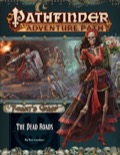
Pathfinder Adventure Path #139: The Dead Roads (Tyrant's Grasp 1 of 6)Paizo Inc.Add Print Edition $24.99 Add PDF $19.99 Non-Mint Unavailable Not Planescape Torment reloaded, but a masterpiece on its ownThis book is a masterpiece, but I find its description to be misleading. While you deal with psychopomps several times, a good share of the adventure is classic dungeoneering, with some foes you might not expect in the Boneyard. Further, the campaign is called out to be survival horror - at least from reading I didn't get the impression, have to agree with Marco here. That said, the book has a LOT of cool ideas and RP hooks. Convince your fellow villagers they are dead now, get advice from a speaking portrait, loot wine bottles from other worlds, face a reluctant foe who tries to frighten you away with dropped notes and maybe convince the final villain to just let you go - this adventure has it all. And while you might consider tooth fairies totally out of place in such a plot, it's impressive how much the author got out of their theme. I looked forward to this AP due to its theme. The opening is different from what I expected, but it's still pretty good. Even if I never make it to GMing it, there is quite a bit of great inspiration here. Further, there are several character options: Two archetypes, a mystery, some rage powers, a handful of duskwalker feats and finally four shabti feats. Personally I like the chance to become immune to paralysis as a barbarian (on top of the other immunities during rage, at high level) and the shabti feats. Finally, the book has the usual Bestiary entries, with the usual high quality. The only flaw is the missing art for the halfling mortic. 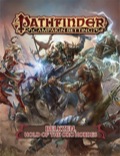
Pathfinder Campaign Setting: Belkzen, Hold of the Orc Hordes (PFRPG)Paizo Inc.
Add
Print Edition
Add PDF $15.99 Non-Mint Unavailable More than just orcsI used this book for two different campaigns and I think it deserves it a better rating. Map & gazetteer: Spoiler:
The book starts off with a map that's stained in blood which is a nice effect. A lot of places are marked there - it would be quite challenging to prepare all of them, so maybe use only a fraction of the map for your campaign. Neighbouring countries and places are missing, which is unfortunate.
The gazetteer is good enough to give an impression on Belkzen. Flood Truce is an interesting concept that adds more depth to orcs. History is summarized within 2 1/2 pages - for me the rise from Underdark and the reign of the Whispering Tyrant were the most interesting parts. Five areas get a four-page write-up: Blood Plains, Conquered Lands, Smokespur, Urgir and Whisperfall. While some of the content is typical for orcs, human settlements, undead menaces and even a hanging monastry are mentioned. Urgir as an orc metropolis should make a great place to visit for adventurers. Adventuring: Spoiler:
Eight gods are described on half a page each - pretty helpful if you want to add more depth and flavor to enemy divine spellcasters. The orc tribe list has some surprises like female chieftains, worship to Sarenrae and wyvern tamers. Conflicts between tribes get some room here, which could contribute to the story.
Orc war machines, siege engines and mounts show a few creative ideas which might add to flavor when battling orcs. The 14 pages of adventure sites are a wealth of starting points for adventures, but you will have to make up most maps and stat blocks for yourself. Only the map of a small human settlement is detailed enough to be used directly, imo. Bestiary: Spoiler:
There are 8 creatures and a template, but I found only a few of them to be actually helpful - which is not so different from regular bestiary books, but still a limitation. Ankhrav is a more powerful ankheg - nice if you want to add a boss to an ankheg encounter. The Burning Child is an unique flavorful creature which probably works better as a story element than as a straightforward encounter. Dahzagan is pretty cool if you want to augment an orc horde with an orc-related outsider. So, overall this book gives you a good introduction into the area, but limited material that can be used directly. Orcs naturally get a lot of attention here, still it's not "Orcs of Golarion, Campaign Setting edition" - which is a blessing, given the high quality of the nonorc material. The book walks a fine line between the classic orc horde and surprising new takes on the greenskins - and succeeds in doing so. There are some decent adventure hooks, which might be the most interesting part. 
Pathfinder Player Companion: Heroes from the FringePaizo Inc.Add Print Edition $14.99 Add PDF $9.99 Non-Mint Unavailable Package of crunch with a few gemsThis Player Companion is a rapid journey through Golarion, the different heritages make you travel between continents in quick succession. Content summary and highlights (in my opinion): Spoiler:
The book starts with some traits which are ok, but sometimes overly specific for an usual campaign (+2 on Bluff & Diplomacy against speakers of Kelish).
Dwarves and elves gain the most material, with 6 pages each. I liked the dragon hexes for dwarves, and there are several more darven weapons. Feats for dwarves are interesting and flavorful, with a focus on hammer throwing and hiding in stony terrain. Only offender here is a breath weapon for dwarves which is totally overpriced for what it does. Elven martials get some love, with an alternate racial trait for being proficient with Eastern weapons and... a Dex based samurai archetype! This variant is probably the best part of the book, replacing the standard juggernaut with a very mobile and still devastating warrior. Gnomes, half-elves and half-orcs get 4 pages each. There is a fey-touched template which can be used for summons and familiars (provided the character has some link to fey), basically a toned down version of the fey creature template in Bestiary 3. Half-elf heritages get a decent feat linked to each: Create a free potion each day (druid spell only, CL 1, needs natural water source, but still), fight better at low HP, be aware of invisible allies or gain haste for 1 round. The half-elf vigilante archetype is straight-forward and nice. Half-orcs gain access to a single feat, depending on heritage, too. Gain a boost to skill checks, catch your foe flat-footed in difficult terrain or get some cold resistance which stacks with any other. There are also two considerable combat focused feats, available for all half-orcs. Halflings get the short end of the stick, with just 2 pages (maybe the author didn't deliver more in time). The Segadan heritage allows to boost your allies a bit, so it's welcome for a support role. Half a page is spent on an equipment trick feat for slings. Surprisingly, ratfolk ninjas get the most part of the next page, with a focus on explosions. They can now pick up tricks to shut down magic items with daily uses or to do more damage by swarming. Even more surprisingly, merfolk and sahuagin (!) get the last page, with a few alternate racial traits and a combat style chain related to Sahuagin blood frenzy. Overall, the book comes with a lot of character options and a limited amount of flavor - as usual for current instances of this product line. There are a few gems, especially the samurai archetype, but otherwise it's rather a book for collectors than a must-have. 
Pathfinder Player Companion: Antihero's Handbook (PFRPG)Paizo Inc.Add Print Edition $14.99 Add PDF $9.99 Non-Mint Unavailable Pretty goodThe amazing:
The good:
The solid:
The bad:
So overall it's a pretty good book with a lot of options, it just lacks a WOW effect and might be handicapped by its topic - I got the impression players often prefer the pure hero of holy light or the bad*** fiend. Quite some similarities to Agents of Evil - which is also a pretty good book. 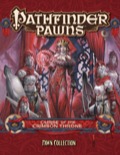
Pathfinder Pawns: Curse of the Crimson Throne Pawn CollectionPaizo Inc.Print Edition Unavailable Add PDF $9.99 Long live the Queen!This pawn collection has several gems: Spoiler:
Intimidating boggards
Two ghosts in a stunning style Great presentations of the 'unexpected allies' (including the companion of the man) Vampire spawns in a great version An efreeti who really looks bad-a** An owlbear skeleton House drakes with 'awww' effect A death oriented derro (inspired me instantly) I guess some people will dig the full presentation of a certain bard If you didn't have enough gray maidens so far, this package clearly fixes that. The queen also gets serious attention - the 'continuing the campaign' version would have been icing on the cake, but ok. There is only a limited amount of generic Bestiary creatures, which I am thankful for. Sabina is missing (as Troodos pointed out in the comments already), but actually I couldn't find really unique artwork for her in the hardcover either. Otherwise all important NPCs seem to be covered. So overall that's a pretty good collection, with an emphasis on Medium sized creatures. The price is as usual for younger softcover pawn packages - rather high in comparison to the big boxes, but you still get something in return. This book opens with an immersive opening letter and stays in character for several pages, when it describes many different categories of aberrations. Switching to conventional rule speech, playable aberrant races are introduced afterwards, based on these categories. Whether they are from deep space, deep sea or deep underground, they bring unusual powers like all-around vision, tentacles, a thick natural armor of +2, psionics or compression. Warptouched are notable for being relatively close to humanoids, so they can walk among them while still having a few odd powers. Favored class bonuses (same for all types of aberrations?) mark the end of this part. The following pages focus on archetypes. Aberrant champion is an archetype which trades away about a third of class features (from whatever class you take) in favor of aberrant powers. There is a psychic archetype which focuses on a confusing mind, while the hunter archetype replaces animal focus and animal companion by aberrant versions (including a rost monster). The summoner archetype summons aberrations, applying a variant of the infernal / celestial template to them. Its thought eater familiar is quite thematic. The remaining half of the book is spent on a sandbox class only available to aberrations. Think summoner with synthesist archetype, but with less balance issues. Its basic properties aren't too impressive (3/4 BAB, d8, Will as only strong save, mediocre skills), but you can choose from thematic options pretty much every level. There is a general path to be chosen at level 1: Focus on psychic duels, physical growth (up to three categories...), confusion and divine casting. Further you can pick up pretty much the same natural weaponry as an eidolon, tentacles get some special attention though. If you are into grapple checks, you get a staggering amount of special abilities to choose from: Attach, constrict, deal Con damage, make them cower or kill them by extracting their brain (well, at level 12 and when they are pretty much screwed anyway). Etc.. There are many eidolon-like abilities like increasing natural AC, adding limbs and getting to fly. But you can also become a solid caster, taking from the mesmerist, psychic or wizard (some illusions only) list - or advancing in psionics. Or a combination of these... There are some caps in favor of balance: You can only have 3 to 7 natural attacks, take additional limbs only so often etc.. The restrictions make sense and shouldn't impact the fun too much. If you want to build a giant claw monster, you can still do so, but it's absolutely not the only option. Depending on the aberration type you play, you also gain some preset thematic powers over the course of levels of this class. They are based on those in the bestiaries, but with attempts to balance them for PCs. If you ever wanted to be a roper or a mimic, here you go. The book ends with a handful of feats, improving your grapple, rend, amount of powers (think Extra Evolution), demoralize, AB and damage vs. other aberrations or your tentacles. So phew, there is a lot of material to play around with. You can scratch the surface by only trading some class features or by just playing an aberrant race - or you go all-in with the sandbox level 1-20 class. The layout is beautiful from the first page. While the images are a bit comic-like, they are quite good for 3pp standards. If someone would point a pistol at my head and force me to complain about the book, I'd probably come up with the slightly tiring long option lists for the class, the odd orange bars at the cover and back or the fact that the first archetype refers to options that are introduced several pages later. But that's really minor - this book is a masterpiece. 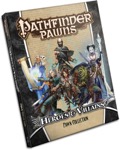
Pathfinder Pawns: Heroes & Villains Pawn CollectionPaizo Inc.Print Edition Unavailable Add PDF $9.99 This box is a treasure chest of PC and NPC pawns. As far as I can tell, a vast majority wasn't printed as pawns before. There is a lot of art from hardcovers (often from archetypes) and PFS modules, but also a few reprints from beginner box and adventure paths. The pawns are sorted by gender and race, but come without any names or numbers, as criticized by some people. I am neutral about the topic, just think it should have been announced openly. Pawn breakdown (as precisely as I can say): Spoiler:
87 human
25 elf 25 dwarf 15 half-orc (with an orc chieftain from Giantslayer as oddball) 14 half-elf 10 halfling 10 gnome 4 orc 4 aasimar 4 drow 4 tiefling 3 ifrit 2 oread 2 sylph 2 undine 2 hobgoblin 2 hobgoblin, Eastern version (?) 2 android 2 catfolk 2 kitsune 2 strix 2 vishkanya (?) 2 tengu 1 fetchling (female) 1 gillwoman 1 ghoran (male) 1 nagaji (female) 1 samsaran (female) 1 wayang (male) 1 of each Castrovel race 6 with mask and body covered, for flexible use 6 of them are mounted (hence Large), all on horses or horse-like creatures. So we get a bit more than 200 pawns here - more than announced, actually. Overall it's a pretty good addition, just a tad too human-centric - and without announcement of the absence of names. 
Pathfinder Pawns: Pathfinder Society Pawn CollectionPaizo Inc.Print Edition Unavailable Add PDF $9.99 Not first choice, but solidI hoped for another big package of NPC / PC pawns, and this hope was more or less fulfilled. There is a lot of material for humans (as usual) and relatively little for the other six core races (rather go for NPC Codex here). Kobolds and goblins get a lot of attention - the former pawns I mostly knew from Monster Codex already, the latter ones are mostly new to me. There is a single pawn for several planetouched races (ifrit, fetchling etc., no tiefling though) and many 'Asian races' (kitsune, nagaji etc.). Tengus and ratfolk get significantly more support: There are four tengus, even a bird rider (nice!), and five ratfolk pawns (some overlap with Monster Codex here). The low point of this collection is the addition of several generic monsters. Yes, they are part of the announcement, but still feel like unnecessary fillers. On the plus side, there are also several unique monsters, like a female ettin, minotaur ghost (?) and colorful lamia matriarch. Quality is great, as usual with Pathfinder pawns - not a single pawn was damaged. Finally for a 'pawn softcover' this one contains a lot of pawns (220) for a moderate price. Where AP packages cost up to 20c per pawn, this one here goes with barely more than 10c. Might be due to the high amount of Medium sized ones. If you are a collector like me, I guess you will be content with this package - the highlights and problems cancel each other out. Maybe it's good for PFS GMs and players, don't know, not my cup of tea. In case you simply want a lot of PC pawns, you are likely better off with the Inner Sea or NPC Codex collection. Or the upcoming Heroes & Villains one. 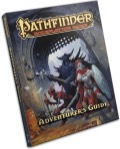
Pathfinder Roleplaying Game: Adventurer's Guide (PFRPG)Paizo Inc.Add Hardcover $39.99 Add PDF $19.99 Non-Mint Unavailable This book has a few issues which will hopefully be rare in future products. Feels weird to write such a negative preview, but it seems necessary. The first issue comes before page 1: The title. Adventurer's Guide - so it's a bigger version of the Strategy Guide? Nope. It's effectively Ultimate Factions of Golarion, but I guess they picked 'Strategy Guide' because it attracts more people. I hope not too many just read the title - because there is only little advice on how to play in this book. The introduction points to campaign setting books (despite the reprints), is not open about the reprints, assumes that some APs are already over and offers a system about joining multiple affiliations which totally favors PCs with Cha 12+ (while stressing 'the GM is the final arbiter' again and again). Not a good start. The table of contents lists 18 factions - wow. That's close to the format of Monster Codex and Villain Codex, which are both great books. Similar to those books, the structure of each chapter is pretty much the same: Roughly one page of introduction into the faction (too short to be really evocative), a few adventure hooks (nice), three usually interesting NPCs, many pages for prestige classes and archetypes, some other character options. Hmm. Many books have flavorful short chapter begins from the perspective of a NPC, this is really missing here. Reprints were addressed a lot in the discussion, I will add some numbers (hopefully counted correctly, but the magnitude should fit): Feats: 67 total, 30 new => reprint ratio ~55%
I didn't pay attention to updated content - because of the additional analysis effort that would have caused and because an update is not necessarily well-received by players. Overall, there are quite some reprints - up to you whether you find it ok. Personally I dislike the announcement "A wealth of new player options" at the back of the book. The individual chapters differ significantly when it comes to creativity, execution and reprint ratio. My preferred playstyle made me very interested in the Aldori section - this one had quite some interesting material, but it doesn't mesh well together. Aldori Artistry is an alternative, feat-saving path to +2 on combat maneuvers, without Combat Expertise (respective Power Attack) - which is nice on its own. But the Aldori Swordlord, Aldori Style and Garen's Discipline still profit slightly from Combat Expertise. The Aldori Defender and Aldori Dueling Mastery both offer a shield bonus to AC - which doesn't stack. I found some redemption for this book where I expected it least: At the Gray Maidens. In the AP they were not my cup of tea, but the chapter comes up with a decent continuation of their story, a well-executed mountless cavalier archetype (with the bonuses of 2 order, nice) and some love for working together in combat. Some people criticize this book only has 192 pages. Personally, I think shorter would have been better - cut away the worst third and you get a solid book. I don't play 5E, but these pawns got me hooked by the list of contents and a fanmade Youtube video (can't find the right one again to link it here, sadly). Ordering them in Europe was a pain, but today the package finally arrived. Wow. Just wow. Quality is excellent, pawns don't smell (sometimes happens after opening), artwork is amazing and the selection of creatures is great. Bestiary boxes try to cover everything, with the drawback of including quite mundane creatures or many instances of a given creature. But Tome of Beasts focusses on twisted, crazy or ugly adversaries. They should be best to fill a huge dungeon, though there is enough material for many other terrain types. Some creatures overlap with Bestiary boxes, but it's less than I would have expected - and in such cases you basically get a different pawn to point to a slightly different specimen. Many creatures get only one pawn, the rest gets two. This is a blessing when it comes to variety and gain per buck, but it restricts encounter design a bit. If you want a big group of similar foes to surround the PCs, you will have to add pawns from Paizo - or from another Tome of Beast Pawns box. ;) Finally, roughly 20 pawns work for PCs, in my opinion - it's not a focus of this collection, but a small plus. Great one! I really hope Kobold Press and other 3pp developers will dive into pawn production more often... The guide has an unfortunate start, focussing on the fugue state and offering little reason to look forward to the campaign - beside luring with Lovecraft. While it was recognized the fugue state can be a problem for players (perceived control loss), only a single sentence is spent on potential positive side effects. To be fair, players can opt out of the fugue state, but the additional work then is appearantly left to the GM and players. Hmm. Players are encouraged to take a weakness / vulnerability for their characters - I would have liked some examples. Maybe the existing drawback trait system could have been used, unlocking an additional positive trait later on. Things get better afterwards, with an extensive list of recommended archetypes and a fair warning about many fear effects making psychic magic more difficult. Core races are encouraged, but wouldn't horror help to integrate exotic races - since all feel in the same boat? The campaign traits are the highlight for me, they are both creative and unusually powerful. Maybe the latter is supposed to compensate a bit for the messy situation the PCs are in. Finally there is some nice brief introduction into Ustalav. I stumbled over an oddity when reading both the guide and part 1 of the AP: A sequence of sentences is completely identical. Given the different audience, it's not a dealbreaker, but it's odd. So this guide works to introduce players who are already interested in the campaign, but it probably doesn't convince many players on the fence. I think fugue is a good idea, but it should have been presented more positively. I am sceptical about 3pp, but the topic, extensive table of contents and a discount made me spend a few dollars on it. It was a good decision. The document covers both business and design. Work efficienctly, focus on the publisher's goals, make players happy etc. - there is a lot of business advice how to do it. Some hints are rather specific for freelancing for the RPG industry, others are quite general. It's helpful advice coming from practice, but I found the repetitions a bit annoying. The second half covers design, with an emphasis on dungeons first, but it moves on to general things like encounters and items. Here the book competes with Paizo products like Ultimate Campaign - and does ok. I especially liked the page about the value of unoccupied rooms. Finally, there is some black-and-white artwork, likely to avoid a pure text book and probably to stretch the document to 32 pages. Only in one case I was able to draw some connection between art and text - I would have preferred diagrams or some example content here. Even just removing these art pages would have been better, for my taste. 
Pathfinder Player Companion: Inner Sea Primer (PFRPG)Paizo Inc.
Add
Print Edition
Add PDF $9.99 Non-Mint Unavailable Great introduction into the campaign settingThis little book (36 pages, 30 of them actual content) is basically the Inner Sea World Guide in a very compressed, player friendly way. History is condensed to a single page, while all the 40 different countries get 20 pages altogether. Faiths, magic and races (including some human cultures) are dealt with in 2 pages each. I feel it's pretty the perfect amount of information to let a new player build the background for their character. On top of that this book contains 3 exclusive archetypes for both fighter and wizard. They read nice, at least - I'm tempted to try one or two. Personally, I like the artwork. The cover is amazing, the map is useful, the 40 (!) flags are creative and the 4 character images are solid to good. I find Kyra's posture a bit weird and repeating the cover at the end seems off, but overall it's great art - as usual. Back to the content though: If you enjoy reading long texts and are content with PDFs, Inner Sea World Guide is the better choice. For another 2$ you get roughly 10 times the content. But I feel most groups can profit from having at least one physical copy of the thinner book, especially when introducing new players. 
Pathfinder Adventure Path #92: The Hill Giant's Pledge (Giantslayer 2 of 6) (PFRPG)Paizo Inc.
Add
Print Edition
Add PDF $19.99 Non-Mint Unavailable Much more than giant slayingAs a quick summary, the three parts of the adventure are diverse and well-thought. The last part is rather difficult to prepare, but it's worth the hassle. There are some giants of different types, although we faced enough other opponents to don't get bored. It's not just hack'n'slay, the group meets a few interesting neutral / friendly NPCs in each part. Some encounters feel a bit tacked on or dull, so I give 4 of 5 stars. Spoiler:
It starts well, with some hints how to deal with enchanted giants and oversized weapons and armor. The first third of the adventure consists of a boat journey with very diverse challenges (probably too diverse for some tastes) and much roleplay potential with the crew. My group learned to like the grumpy captain and enjoyed roleplaying their work on the ship.
The marsh and vault were ok. I am not a big fan of fey (anklebiters, don't feel like worthy foes), so I spiced it up with a succubus causing havoc all over the vault. Some of the original encounters were still good though, especially the rough fight against a big plant creature. The reward was disappointing, so I replaced it with custom weapon upgrades (giant bane makes a difference). Phew, the fort. I had quite some trouble to prepare it, given the many rooms and especially the connections between them. The room numbering is quite confusing, and I am not so fond of the risk that the party encounters the boss very early. After printing the map and putting notes on it I finally got it handled. The feuding factions are an awesome concept, the friendly NPCs are good and the fort has potential for several good battles. Can't say much about the additional content (missions in the area, drake ecology, pathfinder journal, bestiary) - it was an ok read, but didn't find its way into the actual play. I have some general issues with the format of the AP books: Spoiler:
First, the adventure could have used more distinct markers for its three sections. Second, new sections and subsections simply begin wherever the last unit ended. So it's easy to miss them, and you have to flip pages more than necessary. I really prefer the Bestiary format here, even if it needs heavy use of extra text, images and sidebars to start new content at a new page. Finally (and most importantly), some information is scattered all over the book. Major information about the boss can be found at page 7, 34, 39, 55 and 60 - that's quite annoying, especially when reading the PDF. 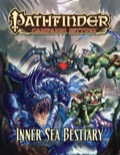
Pathfinder Campaign Setting: Inner Sea Bestiary (PFRPG)Paizo Inc.
Add
Print Edition
Add PDF $15.99 Non-Mint Unavailable A short but great bestiaryI enjoyed reading and skimming this one a lot. The ideas were even more interesting than at regular bestiaries. And it is a pure bestiary - monster listing begins at page 3 and ends at the last content page (63). Monsters are diverse and partially go beyond usual Inner Sea inhabitants, from robots over evil and neutral outsiders to aliens. The book includes two familiars (e.g. parrot fey hybrid), five playable races (not covered by Advanced Race Guide, e.g. monkey goblin) as well as three templates (e.g. charisma sucking vampire). In comparison to regular bestiaries (about 280 pages of monsters) it's expensive (especially the PDF), but I felt it was still worth it. A well-written, thoughtful and funny compilation of four unique NPCs. If you are a GM, you shouldn't miss this free little helper. |




